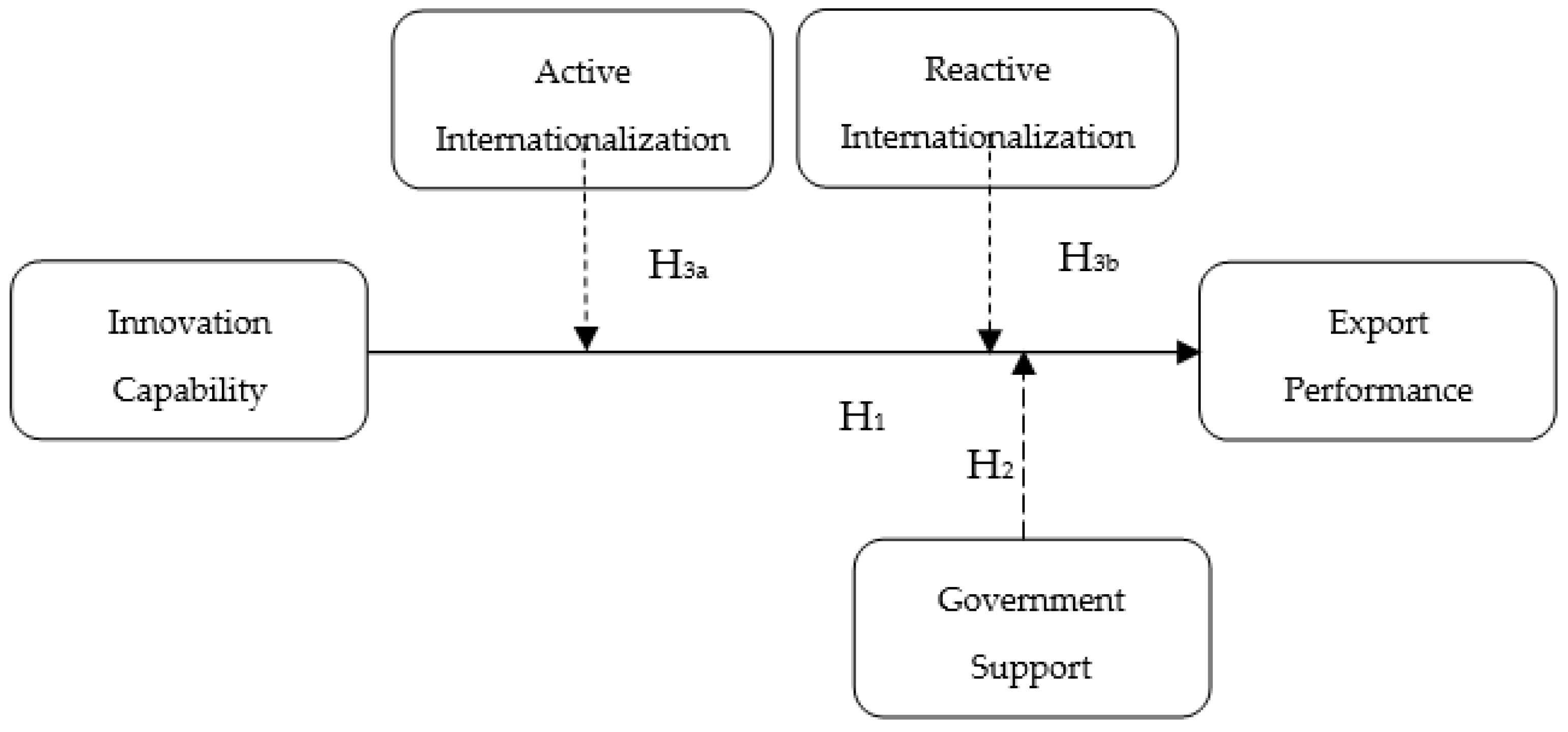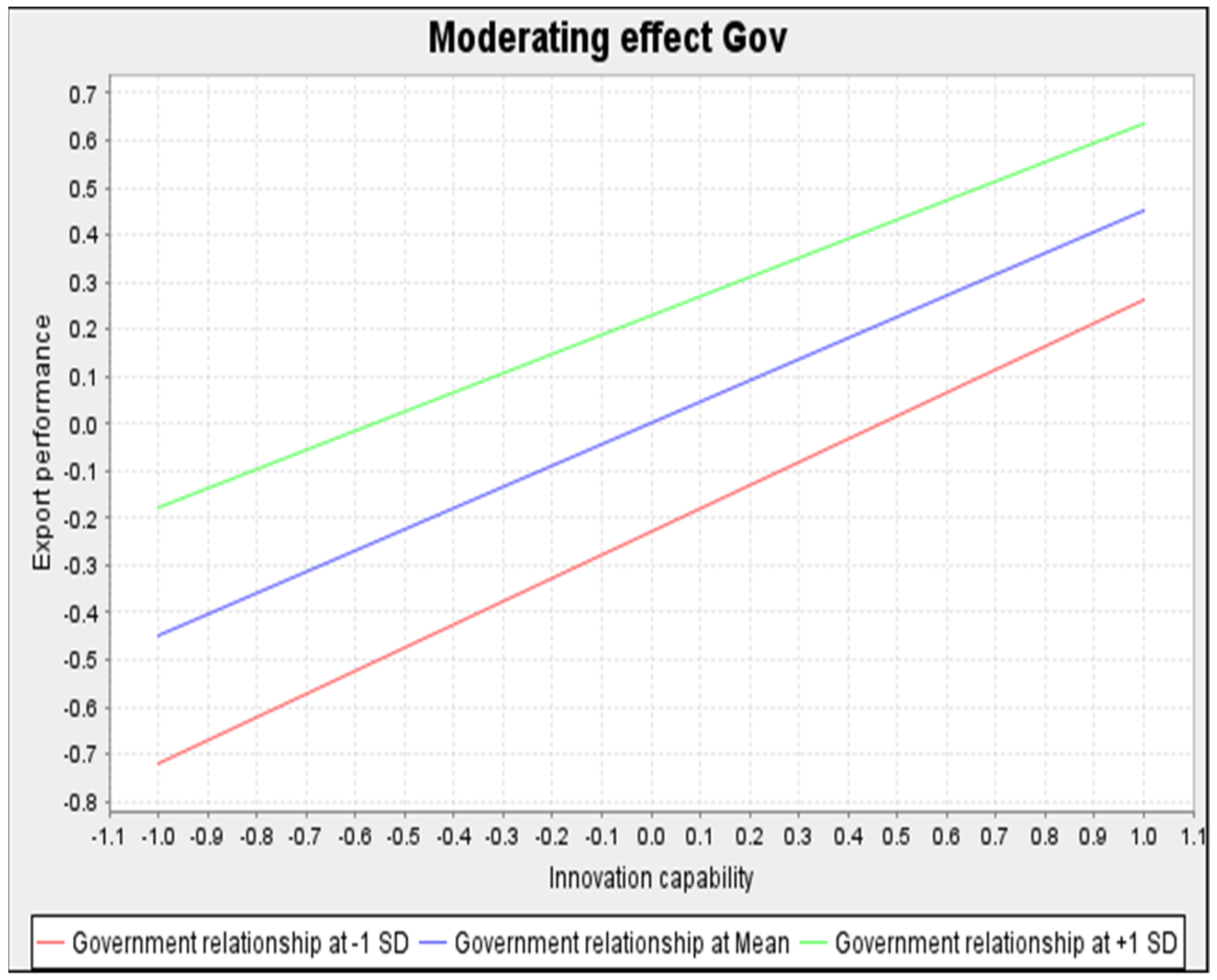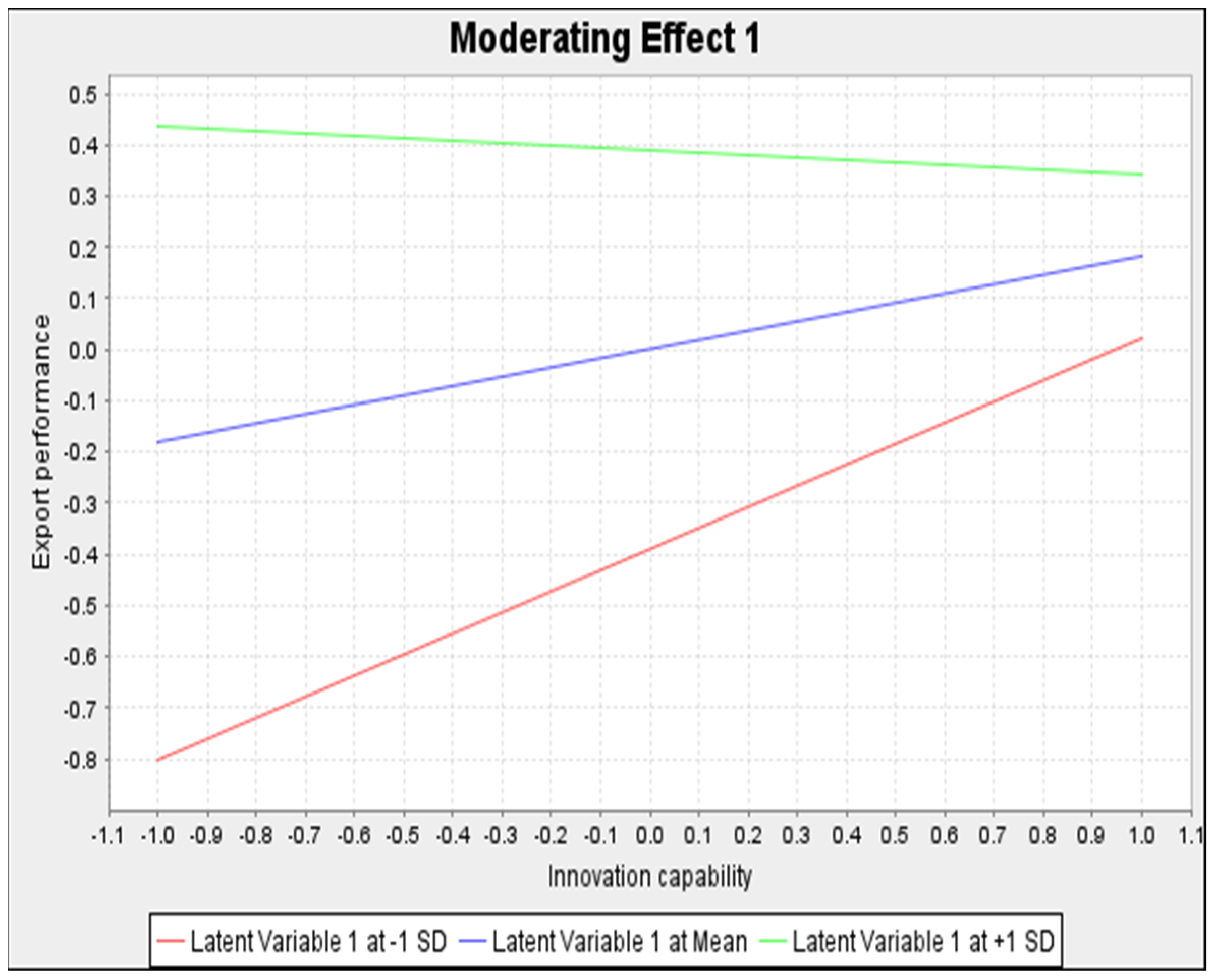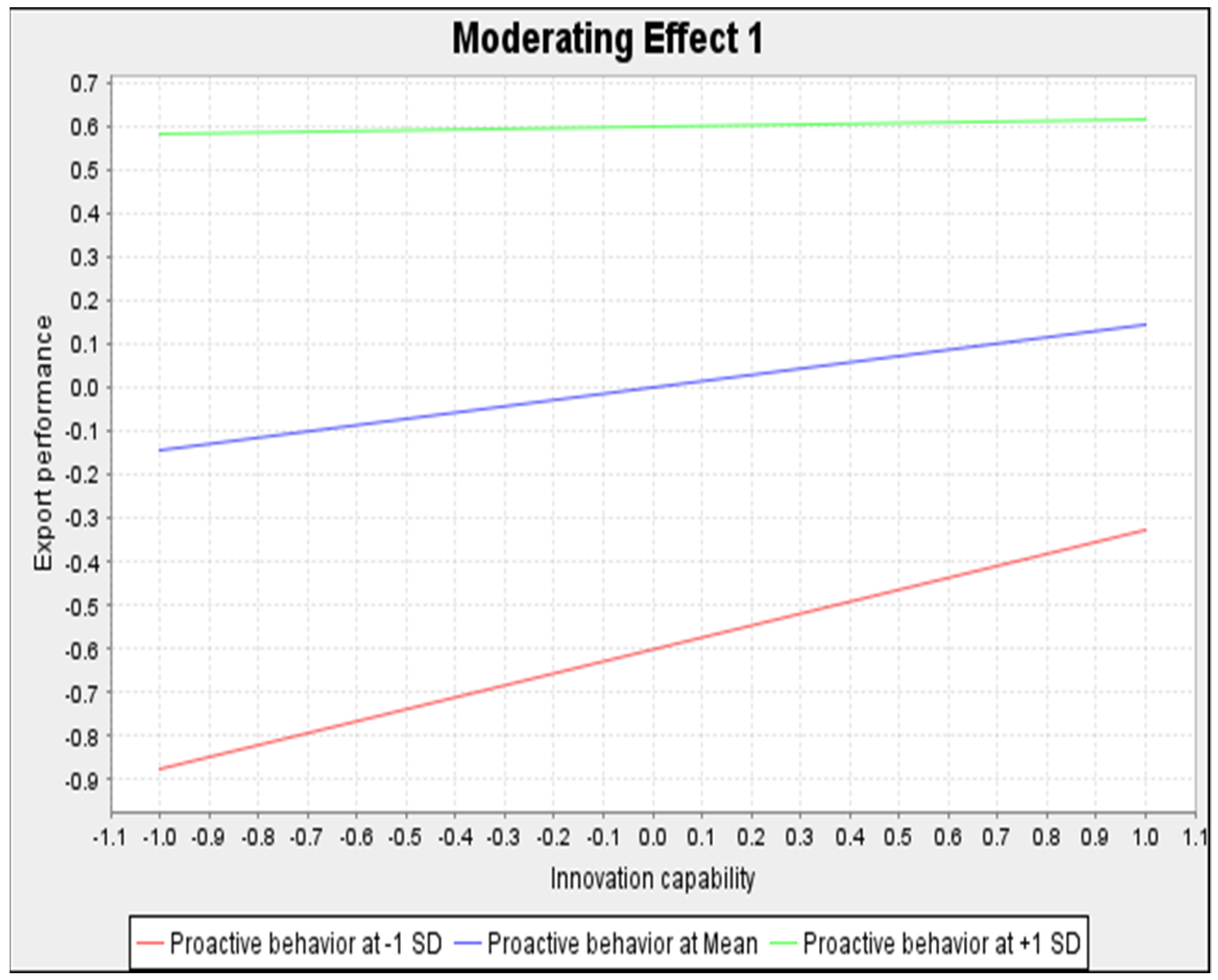1. Introduction
Small and medium-sized enterprises (SMEs) represent over 96% of Mozambique’s business population (
Instituto Nacional de Estatística 2017), but their contribution in terms of gross domestic product (GDP) and employment is still relatively low. SMEs contribute 28% of GDP and 42% in formal employment, facing challenges at the business environment level, namely in terms of access to markets, access to finance, and coordination of support mechanisms (
Ministério da Indústria e Comércio 2016). SMEs need to enhance their competitiveness to increase their economic contribution in emerging economies. Thus, product and process innovation can contribute to promoting structural change among developing countries and support the international competitiveness of SMEs (
Ministério da Indústria e Comércio 2016).
Government programs supporting internationalization play a primary role in the development of businesses, with positive consequences for national economies (
Jalali 2012). These programs play an important role for SMEs, as they have some resource constraints, especially when competing in international markets with larger and more experienced companies. Thus, it is not uncommon for SMEs to seek to explore international markets, even though they have many limitations on resources and skills and little international experience (
Freixanet 2012;
Ayob and Freixanet 2014). Government support, in these situations, is crucial for some SMEs to overcome their limitations and be able to compete in international markets. Take, for example, export support programs (
Comi and Resmini 2020;
Malca et al. 2020). Likewise, given that SMEs have a multifaceted role and are involved in increasing internationalization processes, international support programs have been of added value in allowing SMEs to adjust their resources to contexts in order to progress to broader international markets (
Francis and Collins-Dodd 2004;
Mota et al. 2021).
Another aspect that influences export performance is the type of active/reactive internationalization (
Westhead et al. 2004;
Ribau et al. 2017b). Proactive stimuli can result from SMEs’ behavior and a deliberate search for market opportunities abroad, with the external environment being the source of these stimuli (
Westhead et al. 2004). Moreover, firms embracing active internationalization strategies experience better export performance than those implementing reactive internationalization strategies (
Ribau et al. 2017b). However, little is known on how active/reactive internationalization strategies influence export performance among SMEs from emerging countries.
Based on the two gaps above referred, this paper seeks to add theoretical value by analyzing the influence of both government institutional support and active/reactive internationalization strategies in the relationship between innovation capabilities and export performance, in emerging economies, particularly in Mozambique. For this reason, we raise the following research questions: How do ICs affect export performance in SMEs? What is the moderating effect of institutional factors (relationship with government) on the relationship between ICs and export performance? What is the moderating effect of SMEs’ proactive and reactive internationalization strategies on the relationship between ICs and export performance?
The paper is divided into six sections. After this introduction,
Section 2 reviews the relevant literature including hypothesis development, in which we examine the relationships between ICs and export performance, and the moderating effects of relationship with government and proactive/reactive behavior of SMEs. The research methodology and model are discussed in
Section 3.
Section 4 reveals the discussion of the most significant results, while
Section 5 details the main findings.
Section 6 presents the limitations and future lines of research.
3. Methodology
This study follows a quantitative methodology underpinned by the application of a questionnaire that was created as a result of a thorough literature review of different factors involving innovation capabilities, export performance, government support, and passive/active internationalization.
The questionnaire was applied in Portuguese. As such,
Brislin’s (
1971) recommendations were followed to avoid misunderstandings when translating the questionnaire from English into Portuguese and back to English. At the beginning of the questionnaire, respondents were shown a small introduction of what the questionnaire was about. For operational reasons, the questionnaire was divided into five different sections—one for each topic addressed: innovation capabilities, government institutional support, active/passive internationalization, and export performance—and a final one containing respondents’ data.
The questionnaire was subjected to a pre-test conducted with a convenience sample of eight individuals (three university professors and five managers) in order to check the organization and formatting of the questionnaire, the correct wording, how the respondents understood the questions and the response time required, and to eliminate typos. As a result of the pre-test, some changes were made in the terminology to facilitate the respondents’ understanding. In addition, the number of items per variable was reduced to a minimum to keep the questionnaire to an adequate size. The final version of the questionnaire was made available online to companies via Google Drive LimeSurvey for 4 months, finishing in March 2020 before the outbreak of COVID-19 pandemic in Mozambique. Several rounds of emails were sent to the firms, complemented with telephone calls, to increase the response rate.
This research is grounded on the information obtained with the help of the National Institute of Statistics of Mozambique and with the support of the Investment and Export Promotion Agency (APIEX) of Mozambique, which provided a database of 400 exporting SMEs. Over the course of the survey, 305 responses were obtained. However, 55 questionnaires with incomplete answers were excluded, and a set of 250 questionnaires with complete answers was obtained, constituting 62.5% of the total sample. The characteristics of the sample are presented in
Table 2. The sample size is considered suitable for data analysis using partial least squares structural equation modeling (PLS-SEM) (
Hair et al. 2011).
As this research is based on quantitative approaches, it needs to be supported with reliability and validity analysis to ensure replicability and generalizability. While reliability is concerned with the consistency of measurements, validity is related to the extent to which the study reflects the social phenomena being studied. With reliable and valid measurement, it is possible to replicate the study (
Wahyuni 2012).
The statistical analysis of the data was carried out using partial least squares structural equation models (PLS-SEM), using SmartPLS 3.2. This methodology was justified because its results are robust and because PLS-SEM supports linear regression equations that explain both linear and moderation effects when researchers seek to test and validate exploratory models (
Henseler and Chin 2010).
4. Results
The evaluation of the models was based on reliability, convergent and discriminant validity.
Table 3,
Table 4,
Table 5 and
Table 6 present the factor loadings of the items, which were obtained through bootstrapping with 5000 interactions, the average variance explained (AVE), and composite reliability (CR) for the different constructs under analysis. All items have loadings equal to or greater than the recommended minimum threshold of 0.7 (
Götz et al. 2010) and items below this were removed.
Discriminant validity is shown in
Table 7 using the Fornell–Lacker criterion. It is clear that the square root of AVE is larger than the correlation values of the two variables under analysis (
Hair et al. 2011).
In order to test the four hypotheses put forward, seven different modes were tested, as shown in
Table 8, considering export performance as the dependent variable. Model 1 tests the direct effect of innovation capabilities on export performance. Models 2, 4, and 6 test government institutional support, reactive internationalization behavior, and active internationalization behavior as antecedents of export performance, respectively. Models 3, 5, and 7 test the moderating effects of government institutional support, reactive internationalization behavior and active internationalization behavior on the relationship between innovation capabilities and export performance.
Model 2 in
Table 8 measures the effect of government institutional support as an antecedent of export performance. The results indicate that the explanation of model 2 rises from 25.1% (R
2 = 0.251) to 29.6% (R
2 = 0.296), i.e., government institutional support plays an important role (β = 0.225) as an antecedent of export performance (
Peng and Heath 1996;
Szeto and Kim 2018).
Model 3 presents the mediating relationship of government institutional support in the relationship between innovative capabilities and export performance. A stagnation of the indicators can be noted with regard to the explanation of the models as R
2 presents a marginal increase from 29.6% to 29.8%, as presented in
Table 8. Although
Yi et al. (
2013) and
Stephan et al. (
2015) advocate the importance of the role of government institutional support, the result of this research confirms that the moderating effect is almost null (β = −0.042) and is not statistically significant. Therefore, contrary to that expected, the moderating effect of SMEs’ relationship with the government is non-existent. According to
Yi et al. (
2013), this effect is only positive and significant in contexts where the level of marketing activities among firms is high. In Mozambique, the marketing dimension is considered to be incipient, despite several firms already defining their target customers and adjusting products/services in response to the market (
Ministério da Indústria e Comércio 2016). Meanwhile, it is confirmed that Mozambican SMEs are supported by the government. This is done either through the Institute for the Promotion of Small and Medium Enterprises (IPEME) through Decree no. 47/2008, of 3 December, as the public entity that has the responsibility not only to ensure the implementation of the Strategy for the Development, promotion and dynamization of Micro, Small and Enterprises (MSMEs), or by the Agency for the Promotion of Investment and Exports (APIEX), created through Decree no. 60/2016, of 12 December, the objective of which is to promote and facilitate private, public investment and exports, in accordance with the objectives and goals of the government’s economic policy. However, this effort is not significant as SMEs still face problems such as regulatory barriers, lack of financing, high tax burdens and costs of procedures, and poor access to international markets.
On the other hand, this relationship ceases to make sense in regions where governments are corrupt (
Qian 1996;
Yi et al. 2013). Corruption in developing countries is a hindrance to the growth of SMEs. In Mozambique, in particular, SMEs are the most confronted with bribes and other corrupt practices because they are less equipped to defend themselves and or turn to politicians (
Ministério da Indústria e Comércio 2016). Clearly, if the relationship with the government is far from ideal, which can be justified by the lack of resources of Mozambican SMEs, as well as the inadequacy of support for SMEs that have difficulty competing in international markets, then government institutional support is lost.
The result of the moderating effect of the mediation of government institutional support tested in model 3 is presented in
Figure 2 where it can be seen that as the innovation capability increases the marginal increase in export performance of firms with lower and higher relationship with the government is practically null.
Models 4 and 5 present the relationship between reactive internationalization behavior, export performance, and the mediating effect of reactive internationalization behavior on the relationship between ICs and export performance, respectively.
The results of model 4 indicate that innovation capabilities and reactive internationalization behavior explain 48.2% (R
2 = 0.482) of export performance, and there is a positive and statistically significant relationship between reactive behavior and export performance (β = 0.421), confirming what is postulated in the literature (
Bruyat and Julien 2001;
Westhead et al. 2004;
Ribau et al. 2017a).
Model 5 shows the moderating effect of reactive behavior between innovation skills and export performance, where it is found that the R
2 did not increase relative to model 4 (R
2 = 0.482) and that the moderating effect is negative and statistically significant (β = −0.228). Thus, as shown in
Figure 3, although firms with weak innovation capacity increase their export performance as they react to requests from international markets, firms that are truly innovative end up not benefiting from their export potential, confirming the results presented by
Ribau et al. (
2017a), as reactive SMEs do not rely on innovation to compete in international markets.
The results of model 6 indicate that the relationship between active internationalization behavior and export performance is positive and statistically significant (β = 0.547), so the higher the proactive internationalization behavior, the higher the export performance. Therefore, the previous literature is confirmed (
Bruyat and Julien 2001;
Westhead et al. 2004;
Ribau et al. 2017a).
The moderating effect of proactive behavior does not confirm the hypothesis 3b raised, since, although it is statistically significant, it has a negative effect on moderating the relationship between ICs and export performance (β = −0.129). Thus, as the innovation skills of Mozambican SMEs increase, as well as their proactive behavior, their export performance also increases. However, as shown in
Figure 4, while firms with weak innovation skills increase their export performance by using active internationalization strategies, firms with higher innovation skills do not benefit from this active internationalization strategy.
Table 8 presents the results of this research. The first hypothesis (H1) confirms that the direct effect between ICs and export performance is statistically significant (β = 0.501;
p < 0.000). Thus, H1 is validated. Although the relationship between government institutional support and export performance is statistically significant, the moderating effect of government institutional support on the relationship between ICs and export performance was not shown to be statistically significant (β = −0.042;
p = 0.464). Thus, the second hypothesis H2 cannot be validated. The third hypothesis (H3a) confirms that the moderating effect of reactive internationalization behavior between ICs and export performance is statistically significant, however, the sign is negative (β = −0.228;
p = 0.000), thus rejecting hypothesis H3a. Finally, the fourth hypothesis (H3b) confirms that the moderating effect of proactive behavior between ICs and export performance is statistically significant, however, the sign is also negative (β = −0.129;
p = 0.001), thus rejecting hypothesis H3b.
5. Discussion
The results of model 1 confirm the importance of ICs to Mozambican SMEs confirming previous studies (
Guan and Ma 2003;
Oura et al. 2016;
Ribau et al. 2017a;
Vicente et al. 2015). Thus, it is possible to state that exporting firms from emerging countries depend on their ICs to leverage their export performance. Another important aspect is that the moderating effect of government relationship, which is highly relevant in several contexts (
Comi and Resmini 2020;
Malca et al. 2020;
Mota et al. 2021;
Stephan et al. 2015;
Yi et al. 2013), is not statistically significant, being close to zero (β = −0.042) in the Mozambican case. Thus, as presented in
Figure 2, although export performance improves as innovation skills improve, the marginal difference in export performance is slightly lower as innovation skills improve for higher levels of government relationship. As such, the effect of the government relationship on the relationship between innovation skills and export performance remains virtually unchanged for increasing levels of government relationship.
As seen in
Figure 3 and
Figure 4 and models 5 and 7 in
Table 8, the moderating effect of active and reactive internationalization behaviors of Mozambican firms on the relationship between ICs and export performance is negative and statistically significant. Thus, it can be stated that as innovation skills increase, export performance increases marginally, though much more for firms with relatively modest active strategies than for firms with high levels of active internationalization. This may indicate that Mozambican exporting firms that are more active in international markets face problems penetrating international markets and do not improve their performance as ICs increase. Similarly, with passive internationalization, it is found that with increasing innovation skills, the performance of Mozambican firms decreases with higher levels of reactive exporting strategies, although export performance increases with increasing innovation skills for low levels of reactive exporting behavior. This clearly indicates that Mozambican SMEs may not be benefiting from their innovation skills when trying to push their products into international markets with reactive strategies. Likewise, it can be seen that Mozambican SMEs have difficulty in implementing active internationalization strategies, which may indicate that international competitiveness is not properly assured, despite investment and effort put into improving their innovation capabilities.
One issue is clear: Mozambican SMEs face clear resource constraints to competing in larger international markets, especially because investment in innovation is much more risky and is clearly hampered by the lack of government aid.
6. Conclusions
This research analyzes the moderating effect of government support and active/reactive internationalization of Mozambican SMEs in the relation between ICs and export performance. The target population of the study, 250 Mozambican SMEs, contributed to the literature on SME internationalization in the context of an emerging country. This study was undertaken on the premise that in the context where SMEs carry out their activities, the support that the government provides and active/reactive behavior can influence the relationship between ICs and export performance. Its originality stems from the fact that it deals with how ICs impact export performance in emerging countries, and the effect of government support and active/reactive internationalization strategies on the relationship between ICs and export performance. Both aspects are novel among emerging countries, namely in Mozambique.
Although most Mozambican SMEs, as in other emerging economies, particularly in sub-Saharan Africa, have structural problems, low productivity levels, little modern technology and, as a consequence, low product/service quality, Mozambican exporting SMEs have shown that the use of ICs leads to good export performance.
Paradoxically, government support to SMEs is nonexistent, as is the moderating effect of the relationship of SMEs with the government, i.e., as this effort is not significant, SMEs continue to face problems such as regulatory barriers, lack of funding, high tax burden and cost of procedures, and poor access to international markets. As such, Mozambican SMEs, despite improving their ICs, are not able to leverage their innovation improvements with the government programs available to them. This ends up hindering the normal growth of SMEs, especially in emerging countries whose domestic resources are very limited.
The lack of resources is a general characteristic of SMEs. In the case of emerging economies, this lack of resources is even more prevalent. Although Mozambican SMEs invest in their innovation skills, these are not having the desired effect on export performance because, on the one hand, the lack of resources often makes active internationalization strategies impossible and, on the other hand, government support is non-existent, which does not benefit the internationalization effort undertaken by many companies. It is not enough just to develop internal ICs, it is also necessary to operationalize proactive strategies so that SMEs can face international competitiveness, which requires clear and sustainable public policies and state support, able to make up for the companies’ lack of pressing resources. However, the priority of governments in most emerging countries is oriented towards solving immediate socio-economic problems such as the percentage of the population with low survival rates and high corruption rates. In this context, SMEs aspiring to international business projects find themselves alone, relying on their own resources and capabilities, strangled by an unenthusiastic domestic market.
The proactive or reactive international strategy of Mozambican SMEs only benefits less innovative SMEs. In this context, it can be stated that Mozambican SMEs with high levels of innovation have some difficulty in competing internationally, not because of their lack of ICs, but because of the lack of resources, and perhaps because riskier investments are needed to compete within broader international horizons. This is possible only with effective public governmental business-support policies from the governments of emerging countries.
Clearly, at the government level, the challenge is clear: without governmental support, international business performance is compromised, especially because SMEs in emerging countries need to overcome the liability of newness that they face in international markets by increasing business risk, which ends up hindering active innovation development to implement internationalization strategies. On the other hand, the need for financial resources to adapt the firm’s product portfolio may compromise the success in international competitive markets and relegate Mozambican and emerging countries’ SMEs to the much less demanding domestic market, without solving the lack of competitiveness at the international level. Thus, the great challenge that many emerging economies have to overcome is to create clear government support for companies in order to support them to get to know and compete in international markets through support that increases their innovative capabilities.
At the business level, it is recommended that Mozambican SMEs, in particular, and those in emerging countries, in general, continue to invest in their ICs so that they can improve their internal processes and the development of new products and manufacturing skills, which will support them in marketing and implementing competitive strategies in wider markets. The development of ICs appears to be core to improving international competitiveness. They should also be more demanding of governmental institutions, demanding clear policies to support business competitiveness.
The main limitation of this study is that its content is based on the responses of 250 companies from a single emerging country, Mozambique, which could be complemented by samples from other emerging countries that could give a broader perspective. As it is a cross-sectional study, the intrinsic characteristics of a longitudinal research were not considered. The fact that only one informant per company was considered, and that it was not possible to compare several industrial sectors, may also be considered limitations. However, in the Mozambican context, this would be very difficult to implement. In addition to the limitations presented, future research should take into account the analysis of the context of the internationalization of Mozambican companies, especially their modes of entry and their main international competitors, as well as the qualifications of Mozambican managers and their degree of knowledge of the international context.











